Ethiopian food is both distinctive and delicious, befitting a remarkable country with a cultural heritage that stands out from the rest of Africa.
While the cuisine of Ethiopia is gradually becoming better known, it's no overstatement to say it remains one of the world's best-kept secrets.
Eating Ethiopian-style means rethinking many assumptions you might have about dinnertime -- for most of us this means starting with eschewing cutlery and being ready to get messy fingers.
That's because the foundation of the vast majority of Ethiopian meals is injera, a giant grey spongey pancake-like bread, upon whose strangely rubbery surface are served a vast array of foods, ranging from multi-colored mounds of spicy stews to vegetable curries to cubes of raw meat.
This mode of eating is highly communal, with everyone gathering around a large circular metal tray of injera heavily laden with food as hands go back and forth scooping up from the various piles of foodstuffs with strips of injera torn from the edges.
All this can take some getting used to; tourists have been known to mistake injera for the tablecloth or for kitchen flannel. Also, the bread's bitter, slightly sour taste can put some off. But injera's subtle taste-enhancing power lies in how it contrasts beautifully with, as well as tempers, the fiery sauces it accompanies.
Ethiopians, like Indians, aren't shy of adding spices. One of the most common accompaniments is berbere, an Ethiopian spice mix containing up to 16 constituent elements, including chili powder, fenugreek, ginger, garlic, cardamom and cinnamon.
Another bonus of eating Ethiopian is that injera is made from tef -- the world's smallest grain -- which Ethiopians have grown and obsessed about for millennia. In America and Europe it is increasingly viewed as a "super grain," up there with quinoa and spelt, being high in protein and calcium, and gluten-free.
The result of all of the above will have your taste buds doing somersaults, while also being good for you. Most Ethiopian dishes are nutrient-dense and low in fat.
Beyond the endless dishes on offer, it's essential to try Ethiopian coffee after a meal. Ethiopia is reportedly the birthplace of quality Arabica coffee, and its coffees are widely praised as some of the best in the world.
Here are 15 essential dishes to try:
Tibs
Sliced beef or lamb, pan-fried in butter, garlic and onion, tibs is one of the most popular dishes among Ethiopians.
It comes in a variety of forms, varying in type, size or shape of the cuts of meat used, and can range from hot to mild or contain little to no vegetables. A particularly recommended variation is shekla tibs, in which the strips of meat arrive at your table roasting atop a clay pot stoked with hot coals -- dramatic and delicious.
Historically, tibs was served to pay a compliment or show respect to someone. Today it's still viewed as a special dish, hence its popularity for commemorating special events and holidays. At the same time, though, if you walk into a rowdy bar on a Friday afternoon in Ethiopia's rambunctious capital, Addis Ababa, it's likely that most of the revelers will be enthusiastically ordering and eating tibs.
Typically, the meat of the tibs that arrives at your table has just been cleaved from carcasses hanging outside beside the restaurant's entrance. Don't be put off; meat rarely comes fresher or tastier.
Kitfo
Made from the leanest meat, kitfo is viewed as a big treat by ordinary Ethiopians, while its nutritional powers are also praised.
Similar to French steak tartare, the meat is minced and warmed in a pan with a little butter, mitmita (a stronger version of berbere) and sometimes thyme. Kitfo is typically served leb leb (warmed, not cooked), though you can ask for it to be betam leb leb ("very warmed," which basically means cooked).
Kitfo can be served with aib (like dry cottage cheese) and gomen (minced spinach), a recommended pairing making the meal even more delicious, as well as especially filling -- highly recommended after a hard day's traveling or if one is confronted with a hangover after a long night.
Beyainatu
The name of Ethiopia's most popular vegetarian dish translates as "a bit of every type," hence your injera arrives blanketed in piles of tasty and colorful vegetables, potatoes, curries, lentil stews and more, creating a riot of colors and tastes.
Due to Ethiopia's strong tradition of religious fasting and abstaining from meat on Wednesdays and Fridays, beyainatu is widely available around the country, and served just about everywhere from fancy hotels to tiny food shacks beside the road. Hence when traveling or faced with a menu only printed in Amharic, beyainatu is a safe and simple go-to.
Many visitors to Ethiopia return proclaiming -- regardless of whether they are vegetarian or not -- beyainatu their favorite meal.
Fuul
Popular across East Africa and the Middle East, Ethiopian fuul is a mix of stewed and spiced fava beans eaten by many Ethiopians for breakfast.
Regular fuul is usually served as a modest portion for one -- while still filling you up -- supplemented with an endless supply of fresh bread. So-called special fuul is usually large enough to share, and served with yogurt, tomato, green chili, onion, egg and occasionally avocado. Locals mash this together and season further with salt, additional spices and fresh chilies.
You can tell you are in the right sort of fuul-serving diner if it's brought to you in small metal bowls that are too hot to touch, with eaters using a piece of torn-off bread to grip the bowl's side.
Fuul serves as a healthy fast food, especially in Addis Ababa, where it is often cooked and dispensed out of vast pots, with most customers well fed in under ten minutes before they head off into the teeming city for their day's work.
Tere siga
Not for the faint-hearted, one of Ethiopia's most popular delicacies is cubes of raw red meat. Two people typically order half a kilo of tere siga to share, which is eaten with injera or bread to clasp the meat you carve off the raw slab, and dipped in copious amounts of mitmita.
One of the stories about how Ethiopians developed a love of raw meat is that it was developed as a military tactic during the 16th century so fighters could avoid detection by not having to start fires to cook their meat.
While most Ethiopians seem to suffer no adverse effects from eating tere siga -- the majority avow it makes them feel on top of the world -- eating raw meat does carry a relative health risk. This ranges from tapeworm to salmonella, though this author hasn't experienced any problems post-tere siga (though if one is concerned after a trip to Ethiopia, a simple tablet available from pharmacies can be taken to neutralize any tapeworm risk).
Doro wot
Wot is Ethiopia's version of curry, and the ubiquitous companion of injera. While beef and goat are often used with wot, chicken -- doro in Amharic -- reigns as the wot champion.
Doro wot is made with chicken drumsticks or wings cooked and served in a hot sauce of butter, onion, chilli, cardamom and berbere. In the midst of this stew incongruously bobs a hard-boiled egg. It proves a delicious accompaniment -- typically offered to a guest as a sign of respect.
For Ethiopians, doro wot is the go-to meal of celebration during national and religious festivals (the day before, women can be seen everywhere carrying upside-down clucking chickens by their feet).
Enkulal firfir
While basically just scrambled eggs, which might not sound that exciting, Ethiopia's enkulal firfir is not to be missed at breakfast. Cooked with nitre kibe -- Ethiopian spiced butter -- it is further enhanced with a combination of green and red peppers, chilli, tomatoes and onions, all of which is scooped up with fresh tasty bread rolls, often still warm from the bakery.
A notable feature of enkulal firfir is how fantastically yellow it is, which translates into a far superior taste compared to the results of pallid egg yolks in the west. The omelet version is known as enkulal tibs. Be warned: your appreciation of scrambled eggs back home will never be quite the same after savoring enkulal firfir.
Dulet
For the uninitiated, this dish of mixed meats might be more enjoyable if not translated and explained. It's made with minced tripe (an animal's stomach lining), along with liver and lean beef fried in butter, onions, chilli, cardamom and pepper.
Like kitfo, much of its popularity stems from it being very filling and hitting the spot after a hard-going day or night. Offal has never tasted so good -- give it a go.
Shiro
A lightly spiced chickpea or bean purée, shiro is particularly favored by Ethiopians on fasting days. One of the most unassuming dishes you'll encounter, it can appear as not much more than slop. Don't be deceived, it's very tasty.
Shiro is often prepared with the addition of minced onions, garlic and, depending upon regional variation, ground ginger or chopped tomatoes and chili peppers, further boosting the flavor.
Tegabino shiro is a type of shiro made with heavily spiced legumes, chickpeas, field peas or fava beans, flour, oil or butter, and water brought to the boil, and then brought bubbling all the way to the table in a miniature clay pot.
Ti'hilo
A specialty in Tigray, Ethiopia's most northern region, Ti'hilo is Ethiopia's answer to Swiss fondue, consisting of barley balls pierced by carved sticks with two prongs at the end and dipped in a fiery-looking sauce made from pulses, flour and spices.
As with much eating in Ethiopia, a touch of ceremony attends this dish: A person comes and sits by your table while scooping from a triangular wedge of barley and rolling the barley between hands into little balls to be placed on the tray of injera for you to pierce, dip and eat.
Having long been associated with just a small part of Tigray, around the city of Adigrat especially, the tasty and nutritious benefits of ti'hilo mean it's now catching on and spreading around Ethiopia. If you don't make it up to Tigray, you can track ti'hilo down in Addis Ababa, though you may have to ask around a bit.
Dabbo firfir
Comprising torn-up bits of unleavened bread mixed with clarified butter and berbere, and often accompanied by yoghurt, dabbo firfir is a good example of Ethiopian cooking's ability to take something simple and do much more with it.
Like shiro, it might not look much but dabbo firfir is surprisingly tasty. And as another incentive, in this rare instance Ethiopians are willing to resort to a spoon or fork.
Fatira
A breakfast dish popular around the Horn of Africa, fatira usually comprises a thin pastry top and bottom with scrambled eggs and honey wedged in the middle. Typically served as a large portion, this perfect combination of savory and sweet can happily feed two.
Fatira also comes in a street food version comprising small square pieces cooked in the open on a giant frying pan in the likes of Ethiopia's beguiling eastern city of Harar.
Accompanied by freshly brewed Ethiopian coffee, there aren't many better ways to start a day of exploring Ethiopia.
Asa
Eating fish -- asa -- in Ethiopia is quite an experience. Typically, a fish such as Nile perch is fried and served entirely whole, the gaping mouth of jagged little teeth looking like you have a Piranha on your plate.
As ever, it's eaten by hand with either bread or injera, accompanied by a fiery sauce to dip into. Bar a few bones, Ethiopians eat every bit, and justifiably so -- the grilled fins are particularly tasty.
Asa tibs are chunks of fish marinated in berbere spice and lime juice and then fried in sesame oil, olive oil and paprika, with grated garlic and ginger added. It's a good option if you don't want the hassle of picking out bones or having to contemplate the fish's angry-looking face.
Spriss
Dotted all over Addis Ababa are juice houses -- often not much more than a shack -- serving spriss, delicious juice mixes made from the likes of avocado, guava, papaya, mango, pineapple and orange.
Spriss is mixed by pouring layers of juice -- typically from three fruits -- on top of each other. There's no water added, no sugar and no ice, just unadulterated pureed juice topped with a lime squeezed over the top. Some Ethiopians choose to add a squirt of a purple cordial that the author has never quite identified, though it adds a satisfyingly sweet touch.
A juice is often served with a triangular wedge of sweetened bread, the combination of which serves as an effectively filling snack, especially if you opt for your glass to just be filled with pureed avocado. Spriss is extremely refreshing and a nice sweet break from all the other spicy foods.
Pasta beu injera
Italy's historical involvement in Ethiopia means that if you need a break from endless injera -- or if your stomach is feeling tender and you need to play it safe -- help is at hand in the form of pasta beu atkilt, pasta with vegetables, being readily available all over the country.
Ordering pasta beu siga -- pasta with meat -- will get you something resembling a tasty spaghetti Bolognese.
Alternatively, if you haven't been overwhelmed by injera and you want a quirky mix that would be sure to raise eyebrows in Italy, you could try pasta beu injera: a great dollop of pasta incongruously lumped in the center of injera.
Even in this challenging instance, Ethiopians stay true to tradition: a fork is only used to cut the pasta into manageable bits, after which it is all scooped up with injera clasped between fingers, as usual.
Particularly tricky for first-timers, but one of the most filling meals you can get. Carbs galore
Culled from: CNN (writer: James Jeffrey)

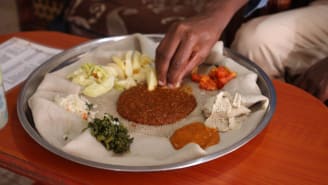
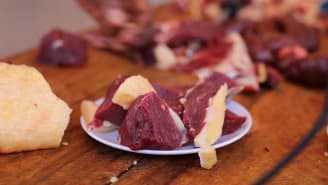
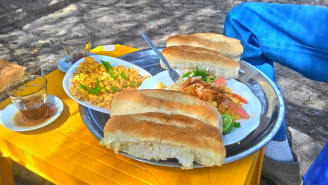
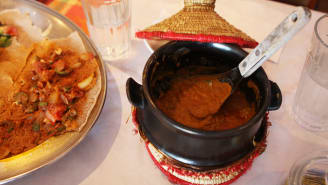
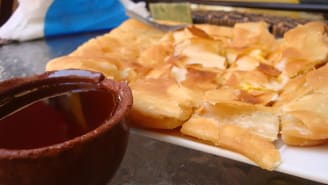



Comments
Post a Comment